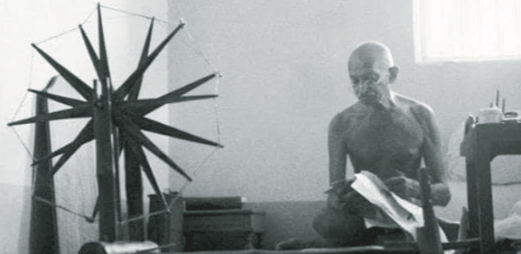Khadi, in its cotton, silk and woolen avatars, is today the rage on international and national fashion ramps. We have celebrated designers the world over, singing paeans to the versatility of Indian handspun textiles and dedicating entire collections to Khadi. For this, we need to thank the simple man who wore a home-spun dhoti and chaddar to steer our nation to freedom.
Gandhi, the Father of our Nation, always believed in the dictum- “Be the change that you want to see.” This is what elevated him from being the ordinary Mohandas Karamchand Gandhi to Mahatma Gandhi, whom we all revere today.
The call for Swadeshi
Even as far back as 1909, when he was yet to embark on his political journey in India, Gandhi felt strongly about the collapse of India’s village economy, and the self-sufficiency that had characterised it. This is evident when we read his Hind Swaraj or Indian Home Rule, even though his ideas were yet to coalesce into a definite pattern back then. Swaraj, Swadeshi, and Sarvodaya were uppermost in his mind, as he visualised an India, free from the trappings of the lopsided progress that the British had brought forth to enslave Indians. He upheld the rejuvenation of the self-sufficient “village-based economy”, which had nurtured and nourished India in the past, and condemned the industrialisation, modern medicine and education which the British had brought into India.
As he matured through direct contact with the poorest of the poor in India, travelling in third -class general compartments in trains across the length and breadth of the country, he realised how the British had looted the country’s wealth, and impoverished the Indian masses. From a country that had once boasted a rich heritage in textiles, India was reduced to surviving on cheap mill-made cloth from Britain. And what better way to bring back India’s lost glory, than reviving the charkha?
Khadi gets a makeover
Burdened by heavy taxes, India’s weavers had been forced to leave their traditional occupation, and become landless agricultural labourers. Indian cotton was being exported by the British to feed their mills in Manchester, and turned into cheap mill-made cloth. Gandhi decided to reverse the trend by mobilising people to spin yarn from Indian cotton, and have it converted to handspun cloth (khadi). Thus, the simple spindle became the precursor of a national economic revival since the 1920s. Since charity begins at home, Congress workers were made to switch to Khadi, even as they took to boycotting all British goods. Soon, the masses followed, and hundreds of thousands of Indians took to wearing Khadi along the length and breadth of the country.
The charkha – which was the epitome of Swaraj and Swadeshi as a direct consequence, found its pride of place on India’s pre-independence flag, as it spelt the path of self-reliance and national prosperity.
Under Gandhi’s tutelage, the All India Khadi Handloom and Handicrafts Board came into existence; this was to formalise itself into the Khadi and Village Industries Commission (KVIC) in 1957 following an Act of the Indian Parliament in the post-independence era. Successive Indian governments have since nurtured our textile heritage by extending loans to weavers, and making yarn available to them at reasonable rates. Stalwarts like Kamaladevi Chattopadhyay and Pupul Jayakar have also nurtured KVIC into rediscovering and promoting India’s traditional textiles and handicrafts, and through Weavers Service Centres, rejuvenating our rich heritage in textiles through modern designs and techniques. Although Gandhi’s idea of an India of “village panchayats” was dismissed by Pandit Jawaharlal Nehru as impractical, his emphasis on khadi and self-sufficiency was always upheld by subsequent Indian governments. To this day, post-liberalisation, India continues to nurture khadi in its many avatars, including poly-vastra. Meanwhile, the rough hand-spun khadi that Gandhi once wore has now given way to the best handlooms, and khadi cottons and silks are coveted items treasured by the rich and famous world over.
Today, every state in India has its handloom and handicraft emporia, whereby traditional textiles and handicrafts are marketed and promoted. The Gujarat government was one of the first to take the lead in roping in outside talent to promote new design techniques for its handloom and embroidered products, with many other states following suit. KVIC has roped in the celebrated fashion designer-Ritu Beri, to promote Khadi through her ‘Vichar Vastra’ collection, while its Bengal counterpart-Biswa Bangla, has brought in designers Agnimitra Paul, Sharbari Dutta and others to promote hand-woven muslin. Many long-forgotten textile traditions – such as the Baluchari of Bengal, or the Patolas of Patan, or the Jamawars of Banaras, that had nearly been lost, have since been brought back to life. Vegetable dyes that had been replaced by chemical alternatives, are once again being brought back by designers who are now returning back to our rich traditions.
Reviving India`s traditional crafts
Today, the interest in rejuvenating our traditional crafts is not confined to textiles. Through its six zonal offices and presence in 29 Indian states, KVIC promotes the production and sale of hand-made herbal creams, hand-pounded spices, bags, footwear and accessories. In addition to the central and state governments, efforts are on by many organisations to promote khadi cotton, silk and woolens at the private level.
The rich array of footwear that India once boasted of is also intriguing European designers like Christian Louboutin, who recently teamed up with Sabyasachi Mukherjee to make the most of Indian jooti designs for his latest collection. Others too, cannot have enough of India, especially since Indian traditional embroidery in gold and silver thread, cool mulmuls and muslin, ikat weaves, wild silks like eri, tussar and munga, raw (ahimsa) silk provide a rich variety of textures and colours to be explored. After all, India is perhaps the only country in the world where every region can boast a multiplicity of weaving styles and techniques, with every state and region boasting an array in dyeing and weaving styles.
While Assam remains the only state in India to produce all four varieties of silk-eri, munga, tussar and mulberry, in addition to cotton fabric, each state can claim its own place in the sun. Thus, Bengal has its Phulia, Dhaniakhali, Tangail and Shantipuri cottons, along with Bishnupuri and Baluchari silks, while Odisha has its cotton and silk ikats, and Sambalpuri cotton and silks. Andhra Pradesh has its Narayanpeth cottons, Pochampally, Gadhwals and silk ikats, Tamil Nadu has its Coimbatore and Kanchipuram cottons and silks, Kerala has its lovely calico cottons, Maharashtra has its Paithani cottons and silks, Gujarat has its Patan patolas, Rajkot silks and Bandhani cottons, Rajasthan its vegetable dyed cotton fabrics and leheriyas, Punjab its unique Phulkaris and woven rugs, Himachal Pradesh has its khadi woolens, Uttar Pradesh has its Chikankari and Mukaish embroidered fabrics, Benarasi silks and Mou cottons, Bihar its tussar silks, and Madhya Pradesh its Maheshwari, Chanderi and tussar silk fabrics.
As India progresses on in its journey of self-discovery where its textiles and handicrafts are concerned, it is time we acknowledged our debt to Mahatma Gandhi and his humble spinning wheel that set us on the path of a quiet revolution for all time.


 [/column]
[/column]